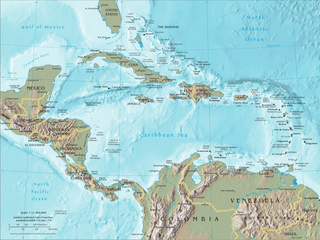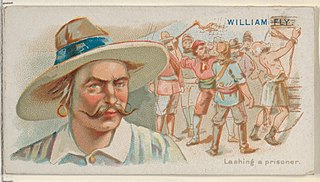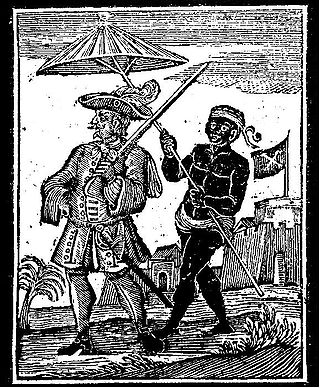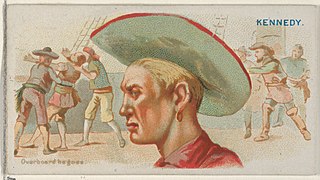
William Kidd also known as Captain William Kidd or simply Captain Kidd, was a Scottish privateer. Conflicting accounts exist regarding his early life, but he was likely born in Dundee and later settled in New York City. By 1690, Kidd had become a highly successful privateer, commissioned to protect English interests in North America and the West Indies.

The era of piracy in the Caribbean began in the 1500s and phased out in the 1830s after the navies of the nations of Western Europe and North America with colonies in the Caribbean began combating pirates. The period during which pirates were most successful was from the 1660s to the 1730s. Piracy flourished in the Caribbean because of the existence of pirate seaports such as Port Royal in Jamaica, Tortuga in Haiti, and Nassau in the Bahamas. Piracy in the Caribbean was part of a larger historical phenomenon of piracy, as it existed close to major trade and exploration routes in almost all the five oceans.

Bartholomew Roberts, born John Roberts, was a Welsh pirate who was, measured by vessels captured, the most successful pirate of the Golden Age of Piracy. During his piratical career, he took over 470 prize ships. Roberts raided ships off the Americas and the West African coast between 1719 and 1722; he is also noted for creating his own pirate code, and adopting an early variant of the Skull and Crossbones flag.

John Rackham, commonly known as Calico Jack, was an English pirate captain operating in the Bahamas and in Cuba during the early 18th century. His nickname was derived from the calico clothing that he wore, while Jack is a nickname for "John".
Robert Culliford was a pirate from Cornwall who is best remembered for repeatedly checking the designs of Captain William Kidd.

Stede Bonnet was a Barbadian-born pirate and military officer, known as the Gentleman Pirate for the reason that he was a moderately wealthy landowner before turning to a life of crime. Bonnet was born into a wealthy English family on the island of Barbados, and inherited the family estate after his father's death in 1694. Despite his lack of sailing experience, Bonnet decided he should turn to piracy in the spring of 1717. He bought a sailing vessel, the Revenge, and travelled with his paid crew along the Eastern Seaboard of what is now the United States, capturing other vessels and burning other Barbadian ships.

William Fly was an English pirate who raided New England shipping fleets for three months in 1726 until he was captured by the crew of a seized ship. He was hanged in Boston, Massachusetts and his body publicly exhibited as a warning to other pirates. His death is considered by many to mark the end of the Golden Age of Piracy.

Benito de Soto Aboal Pontevedra is in Galicia in northern Spain where the language is close to Portuguese, which has confused some sources that say he was Portuguese. He was captain of the pirate ship Defensor de Pedro, sometimes incorrectly named as the Burla Negra, that was responsible for several piracies in the Atlantic in 1828, in a period of increased piracy following the independence of the new states of South America. The most notable attacks were on the British Indiaman Morning Star and the American ship Topaz, which involved great violence. De Soto was captured and tried in Gibraltar on 20 January 1830 and he was hanged on 25 January. Other members of his crew were captured in Spain. Their trial there began on 19 November 1829 and ten men were executed on 11 and 12 January 1830.

Henry Every, also known as Henry Avery, sometimes erroneously given as Jack Avery or John Avery, was an English pirate who operated in the Atlantic and Indian oceans in the mid-1690s. He probably used several aliases throughout his career, including Benjamin Bridgeman, and was known as Long Ben to his crewmen and associates.

Edward "Ned" Low was a notorious pirate of English origin during the latter days of the Golden Age of Piracy, in the early 18th century. Low was born into poverty in Westminster, London, and was a thief from an early age. He moved to Boston, Massachusetts, as a young man. His wife died in childbirth in late 1719. Two years later, he became a pirate, operating off the coasts of New England and the Azores, and in the Caribbean.

Walter Kennedy was an English pirate who served as a crew member under Howell Davis and Bartholomew Roberts.
Dirk Chivers was a Dutch pirate active in the Red Sea and Indian Ocean.

Charles Gibbs was the pseudonym of an American pirate, born James D. Jeffers. Jeffers was one of the last active pirates in the Caribbean during the early 19th century, and was among the last persons to be executed for piracy by the United States.

Edward Jordan (1771–1809) was an Irish rebel, fisherman, and pirate in Nova Scotia. He was typical of the violent but short-lived pirates in the 19th century following the end of the "Golden Age of Piracy" in the 18th century.
Seal Harbour is a community in the Canadian province of Nova Scotia, located in Guysborough County. Located on the east side of Isaac's Harbour, it was named for the abundance of seals once found there. Founded as a fishing settlement, it became a gold mining community with the initial discovery in the area in 1867, with further discoveries in 1892. Gold mining near Seal Harbour peaked in 1904–1907. The mines briefly reopened from 1939 to 1942 and then closed, leaving fishing and lumbering as the main industries. Some gold exploration is still carried out in the area by the Orex Exploration company.

John Phillips was an English pirate captain. He started his piratical career in 1721 under Thomas Anstis, and stole his own pirate vessel in 1723. He died in a surprise attack by his own prisoners. He is noted for the articles of his ship, the Revenge, one of only a few complete sets of pirate articles to survive from the so-called Golden Age of Piracy.

The Atlantic World refers to this area between the European colonisation of the Americas (1492-) and the early nineteenth century. Piracy became prevalent during this era because of the difficulty of policing this vast area, the limited state control over many parts of the coast and the competition between different European powers. The best known pirates of this era are the Golden Age pirates (c.1650-1730) who roamed the seas off the coast of North America, Africa and the Caribbean.
Susannah Buckler, also known as Mrs. Matthews, was a convicted thief and prostitute from Dublin, Ireland. who was involved in a bloody convict mutiny aboard the brigantine Baltimore bound for Annapolis, Maryland. She is notorious for her escape from authorities in Nova Scotia following the mutiny.
The Lennie was a Canadian-built barque whose crew mutinied in 1875, en route to New York for orders.

The Flying Gang was an 18th-century group of pirates who established themselves in Nassau, New Providence in the Bahamas after the destruction of Port Royal in Jamaica. The gang consisted of the most notorious and cunning pirates of the time, and they terrorized and pillaged the Caribbean until the Royal Navy and infighting brought them to justice. They achieved great fame and wealth by raiding salvagers attempting to recover gold from the sunken Spanish treasure fleet. They established their own codes and governed themselves independent from any of the colonial powers of the time. Nassau was deemed the Republic of Pirates as it attracted many former privateers looking for work to its shores. The Governor of Bermuda stated that there were over 1,000 pirates in Nassau at that time and that they outnumbered the mere hundred inhabitants in the town.















